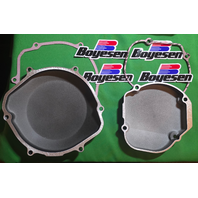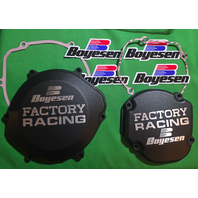You have no items in your shopping cart.
While uncommon, some items may ship from a separate warehouse
About the Clutch Cover
Features
Set your ride apart from the rest with the ultimate look in race performance
Lightweight factory clutch covers provide years of outstanding protection; guaranteed not to warp
Individually surfaced for a perfect, leak-free fit
Super-tough, powder-coated finish resists weathering and wear and tear
Asbestos-free gasket is bound with nitrile for tight, leak-free seal
Specs
Units Each
Model Factory Racing
Riding Style Off-Road
Color/Finish Black / Powder-Coated
Type Clutch
Product Name Cover
Package info
Weight 0.85 lbs
Height 2.67
Length 8.07
Width 7.95
About the Ignition Cover
Features
Look like a professional with the Factory Ignition Cover
Seals properly, guarding inside of engine from dirt and water and outlasts stock covers
Boyesen Factory Covers are cast from the highest grade of aluminum and are strong yet lightweight
Super-tough, powder-coated finish resists weathering and wear and tear
Specs
Color/Finish Powder-Coated / Black
Model Factory Racing
Product Name Cover
Units Each
Riding Style Off-Road
Type Ignition
Material Aluminum
Package info
Weight 0.6 lbs
Height 2.55
Length 7.99
Width 7.87
The 2002-2007 Honda CR250R marks the final chapter in Honda’s legendary two-stroke motocross lineage, representing the pinnacle of their 250cc two-stroke motocross development. These bikes are cherished for their modern technology, race-winning potential, and symbolic status as the last of Honda’s production two-stroke motocross bikes.
Here's an in-depth overview of the 2002-2007 Honda CR250R:
Overview and Historical Context:
By 2002, the motocross world had begun shifting toward four-stroke bikes, particularly following Yamaha's introduction of the groundbreaking YZ250F and YZ450F. Despite this shift, Honda committed significant resources to further refining its two-stroke CR250R. The 2002-2007 CR250R is recognized for its remarkable handling, advanced aluminum frame, and potent—but challenging—RC-style case-reed engine.
2007 was the final production year for Honda's two-stroke CR250R, marking the end of an era.
Engine and Performance:
- Engine Specifications:
- 249cc single-cylinder two-stroke
- Liquid-cooled, RC-style case-reed induction (introduced in 2002)
- 5-speed close-ratio gearbox
- Performance Traits:
- Aggressive, explosive powerband
- Notoriously strong mid-to-top-end performance, but less low-end torque compared to earlier models
- The RC-style case-reed induction design provided increased top-end power but made powerband tuning more challenging, demanding skillful throttle control
- Carburetion:
- Mikuni TMX carburetor (introduced in 2002), later refined over the years but consistently tricky to dial in perfectly
Chassis and Suspension:
- Frame:
- Third-generation twin-spar aluminum frame introduced in 2002; continually refined for optimized handling and reduced weight
- Recognized for improved flexibility and rider comfort compared to earlier aluminum frames (1997-2001)
- Suspension:
- Premium Showa inverted forks and Showa Pro-Link rear shock with fully adjustable compression and rebound damping
- Improved stock suspension performance, particularly notable in 2005-2007 models, making the bike competitive out-of-the-box
- Braking System:
- Powerful Nissin hydraulic disc brakes (front and rear), highly effective and reliable throughout these years
Evolution by Model Year (2002-2007):
2002-2004:
- Introduction of the RC case-reed induction system, offering strong, but somewhat peaky power.
- Riders noted the engine’s demanding power delivery, requiring careful carburetion tuning.
- Suspension and frame improvements significantly boosted handling and track feel.
2005-2007:
- Refined suspension, better fork action, and improved rear shock setup out-of-the-box.
- More balanced aluminum frame geometry improved rider comfort and cornering performance.
- Carburetion improvements made the bikes easier to tune compared to earlier RC-valve models, though still more finicky than traditional reed-valve engines.
- The 2007 model—highly desirable—represents the culmination of Honda’s two-stroke motocross engineering.
Racing Success and Legacy:
During this period, Honda’s factory race teams and privateers began transitioning heavily toward four-stroke machines, notably the CRF450R and CRF250R. Still, the CR250R remained a popular choice among two-stroke enthusiasts, amateur racers, and hardcore purists.
- Ricky Carmichael famously rode a CR250R to dominant victories early in the era (2002), marking one of the last great moments of two-stroke racing supremacy in AMA Supercross and Motocross.
- Honda’s shift to four-strokes signaled the decline of professional-level two-stroke racing, making these final CR250R models historically significant.
Collectability and Market Status:
Due to its status as Honda’s final two-stroke motocross bike, the 2002-2007 CR250R models hold significant collectible value, especially well-maintained, low-hour examples.
- Most collectible:
2007 model (final production year), prized for historical significance and refined chassis. - Good aftermarket parts availability, active enthusiast community, and continued vintage-class racing support keep these bikes highly desirable.
Common Issues & Maintenance:
- Carburetion & Jetting:
- The Mikuni TMX carburetor introduced in 2002 often required precise tuning to optimize performance and avoid a flat or bogging sensation.
- Power Valve (RC Valve) Maintenance:
- Regular cleaning is essential for maintaining optimal engine performance.
- Top-End Rebuilds:
- Recommended every 40-60 hours of use for peak performance.
- Suspension Seals & Bearings:
- Routine service of forks and linkage bearings is important to maintain handling quality.
Summary:
The 2002-2007 Honda CR250R represents both the height and end of Honda’s iconic two-stroke motocross lineage. Its distinctive RC-valve engine and refined aluminum frame set new standards in performance, even as the motocross landscape transitioned to four-stroke technology. These bikes remain highly coveted today as collectors' items and competitive platforms for two-stroke enthusiasts.
.jpg)








